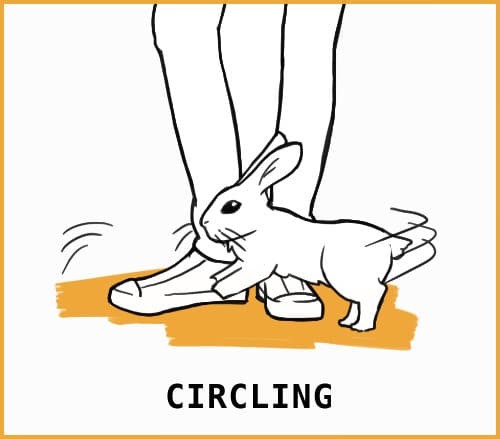Are Bunnies Difficult Pets to care for, or are they the perfect addition to your family? Many potential pet owners wonder about the challenges and rewards of rabbit ownership. At PETS.EDU.VN, we’ll explore the truth about keeping bunnies, covering everything from their dietary needs to their social requirements. Discover if a bunny is the right pet for you, and learn how PETS.EDU.VN can help you every step of the way with expert advice and rabbit care solutions. Get ready to hop into the world of rabbit companionship! With insight into rabbit behavior and health management, you’ll be well-equipped for informed pet ownership.
1. Understanding the Commitment: Are Bunnies Difficult Pets?
So, are bunnies difficult pets? While rabbits can be wonderful companions, it’s important to understand the commitment involved. They require more care than many people initially realize. Bunnies aren’t just low-maintenance pets you can leave alone; they need a specific diet, regular exercise, and plenty of social interaction.
Taking care of rabbits is rewarding, but it does demand dedication. Potential owners should be aware of the following factors that contribute to the level of difficulty in keeping bunnies:
- Dietary Needs: Rabbits have sensitive digestive systems, requiring a balanced diet of hay, fresh greens, and limited pellets.
- Housing Requirements: They need spacious enclosures and regular access to safe exercise areas.
- Social Interaction: Rabbits are social animals and need companionship, either from humans or other rabbits.
- Veterinary Care: Finding a rabbit-savvy vet is essential, and costs can be higher than for cats or dogs.
- Chewing Behavior: Rabbits love to chew, so homes need to be rabbit-proofed to protect furniture and electrical cords.
We at PETS.EDU.VN recognize these needs and provide you with expert information and services to help you every step of the way. To assist in successfully integrating these adorable companions into your life, we offer the resources and knowledge you need.
2. The Joys of Bunny Ownership: Why Rabbits Make Great Pets
Despite the challenges, owning a rabbit can be incredibly rewarding. Rabbits have unique personalities and offer many joys to their caretakers. Here’s why many people find rabbits to be great pets:
- Quiet Companions: Rabbits are generally quiet, making them suitable for apartment living.
- Litterbox Trained: They can be litterbox trained, making cleanup relatively easy.
- Clean Animals: Rabbits groom themselves regularly and don’t typically have a strong odor.
- Long Lifespan: With proper care, rabbits can live for 8-12 years, providing long-term companionship.
- Trainable: Rabbits are intelligent and can be trained to do tricks and follow commands.
- Affectionate: Many rabbits enjoy being petted and will show affection to their owners.
- Gentle Nature: Rabbits are usually gentle and non-aggressive, especially when properly socialized.
- Adorable: Let’s face it, bunnies are incredibly cute and fun to watch!
At PETS.EDU.VN, we celebrate the unique bond between humans and rabbits. Our goal is to help you maximize the joys of bunny ownership by providing the resources and support you need to create a happy and healthy life for your furry friend.
3. Understanding Rabbit Behavior: What to Expect
Understanding rabbit behavior is crucial to being a responsible owner. Here are some common rabbit behaviors you should be aware of:
- Binkies: These are joyful jumps and twists that rabbits do when they’re happy.
- Circling: Rabbits may circle your feet to get your attention or show affection.
- Thumping: Rabbits thump their hind legs to signal danger or express displeasure.
- Chewing: As mentioned earlier, chewing is a natural behavior for rabbits, so provide plenty of safe chew toys.
- Grooming: Rabbits groom themselves and each other to maintain cleanliness and bond.
- Nudging: Rabbits may nudge you to ask for attention or food.
- Teeth Grinding: Soft teeth grinding usually indicates contentment, while loud grinding can signal pain.
4. Meeting Dietary Needs: A Balanced Rabbit Diet
Meeting a rabbit’s dietary needs is critical for their health and well-being. A balanced rabbit diet consists of:
- Hay: Unlimited access to fresh, grass-based hay (such as timothy, orchard, or oat hay) is essential for digestion and dental health.
- Leafy Greens: Provide 1-2 cups of fresh, leafy greens daily, such as romaine lettuce, kale, and parsley.
- Pellets: Offer a limited amount (1/4 to 1/2 cup per day) of high-quality rabbit pellets.
- Treats: Offer healthy treats in moderation, such as small pieces of fruit or vegetables.
Avoid feeding rabbits sugary treats, processed foods, or foods high in carbohydrates, as these can cause digestive problems. At PETS.EDU.VN, we offer detailed guides on rabbit nutrition, including safe and unsafe foods, and how to transition your rabbit to a new diet. Our team of experts can also help you create a customized meal plan tailored to your rabbit’s specific needs.
5. Housing and Environment: Creating a Safe Space for Your Bunny
Creating a safe and comfortable environment is vital for a happy rabbit. Consider the following when setting up your rabbit’s housing:
- Enclosure Size: The enclosure should be at least 3-4 times the length of your rabbit when they’re stretched out.
- Material: Wire cages with solid bottoms are ideal for cleaning.
- Litterbox: Provide a litterbox filled with rabbit-safe litter.
- Bedding: Soft bedding such as hay or fleece can provide comfort.
- Chew Toys: Offer plenty of safe chew toys to keep your rabbit entertained and prevent them from chewing on furniture.
- Exercise Space: Rabbits need at least 1-2 hours of exercise outside their enclosure each day.
5.1 Rabbit-Proofing Your Home
Rabbit-proofing your home is essential to protect your belongings and keep your rabbit safe. Take the following steps:
- Cover Wires: Cover electrical cords with plastic tubing to prevent chewing.
- Protect Furniture: Place plastic mats or covers over furniture to prevent damage.
- Block Access: Block access to areas that are off-limits, such as under the bed or behind furniture.
- Remove Hazards: Remove any potentially hazardous items, such as cleaning supplies or toxic plants.
At PETS.EDU.VN, we offer a variety of rabbit-safe products to help you create a secure and enriching environment for your pet.
6. Health and Veterinary Care: Keeping Your Bunny Healthy
Maintaining a rabbit’s health requires regular veterinary care and attention to their specific needs. Here are some key aspects of rabbit health:
- Regular Checkups: Schedule annual checkups with a rabbit-savvy vet to monitor your rabbit’s health and catch any potential problems early.
- Spaying/Neutering: Spaying or neutering your rabbit is essential for their long-term health and can prevent behavioral problems.
- Vaccinations: Vaccinate your rabbit against common diseases such as myxomatosis and rabbit hemorrhagic disease (RHD).
- Dental Care: Rabbits’ teeth grow continuously, so provide plenty of hay and chew toys to help wear them down and prevent dental issues.
- Parasite Control: Protect your rabbit against parasites such as fleas, mites, and worms.
6.1 Common Health Issues in Rabbits
Be aware of the following common health issues in rabbits:
- Gastrointestinal Stasis (GI Stasis): This is a potentially life-threatening condition in which the digestive system slows down or stops.
- Dental Problems: Overgrown teeth can cause pain and difficulty eating.
- Respiratory Infections: Rabbits are susceptible to respiratory infections such as snuffles.
- Ear Infections: Ear mites or other infections can cause discomfort and hearing loss.
- Sore Hocks: This is a condition in which the skin on the bottom of the feet becomes inflamed and ulcerated.
- Uterine Cancer: Unspayed female rabbits are at high risk of developing uterine cancer.
At PETS.EDU.VN, our team of experienced veterinarians and rabbit experts can provide you with comprehensive information and support to keep your bunny healthy and happy.
7. Socialization and Companionship: Meeting Your Bunny’s Social Needs
Rabbits are social animals and need companionship to thrive. Here are some ways to meet your rabbit’s social needs:
- Bonded Pairs: Consider getting two rabbits that have been bonded together. Bonded rabbits will groom each other, play together, and provide each other with companionship.
- Human Interaction: Spend time with your rabbit each day, petting them, talking to them, and playing with them.
- Enrichment: Provide your rabbit with toys, puzzles, and other enrichment items to keep them mentally stimulated.
- Training: Training your rabbit can be a fun and rewarding way to bond with them and provide mental stimulation.
If you’re considering getting a rabbit, it’s important to consider whether you can provide them with the social interaction they need. Rabbits that are left alone for long periods of time can become bored, depressed, and destructive.
8. Training Your Rabbit: Teaching Tricks and Good Behavior
Rabbits are intelligent animals and can be trained to do tricks and exhibit good behavior. Here are some tips for training your rabbit:
- Positive Reinforcement: Use positive reinforcement techniques such as treats and praise to reward desired behaviors.
- Consistency: Be consistent with your training and use the same commands each time.
- Patience: Be patient and don’t get discouraged if your rabbit doesn’t learn a trick right away.
- Short Sessions: Keep training sessions short and fun to keep your rabbit engaged.
8.1 Basic Commands for Rabbits
Some basic commands you can teach your rabbit include:
- Come: Teach your rabbit to come when called.
- Sit: Teach your rabbit to sit on command.
- Stay: Teach your rabbit to stay in one place.
- Litterbox Training: Teach your rabbit to use a litterbox.
At PETS.EDU.VN, we offer a variety of training resources to help you teach your rabbit tricks and good behavior.
9. Rabbits and Children: A Good Match?
Rabbits can make great family pets, but it’s important to consider whether they are a good match for children. Here are some factors to consider:
- Gentle Handling: Children need to be taught how to handle rabbits gently to avoid injuring them.
- Supervision: Children should always be supervised when interacting with rabbits.
- Responsibility: Children may not be able to handle the full responsibility of caring for a rabbit.
If you’re considering getting a rabbit for your child, make sure they understand the responsibility involved and are willing to treat the rabbit with kindness and respect.
10. Finding the Right Rabbit: Adoption vs. Buying
When getting a rabbit, you have the option of adopting from a shelter or buying from a breeder. Here are some pros and cons of each option:
10.1 Adoption
Pros:
- Saves a life
- Often less expensive than buying from a breeder
- Rabbits may already be spayed/neutered and vaccinated
- Supports local animal shelters
Cons:
- May not know the rabbit’s history or temperament
- May have health or behavioral issues
- Limited selection of breeds
10.2 Buying from a Breeder
Pros:
- Can choose a specific breed
- May know the rabbit’s history and temperament
- May have health guarantees
Cons:
- Can be more expensive than adopting
- May support unethical breeding practices
- May not be spayed/neutered or vaccinated
At PETS.EDU.VN, we encourage you to consider adopting a rabbit from a local shelter. Adoption saves lives and gives deserving animals a second chance.
11. Addressing Common Misconceptions About Rabbits
There are many misconceptions about rabbits that can lead to poor care and misunderstandings. Let’s address some of the most common ones:
- Misconception: Rabbits are low-maintenance pets.
- Reality: Rabbits require a specific diet, regular exercise, and plenty of social interaction.
- Misconception: Rabbits are good pets for young children.
- Reality: Rabbits require gentle handling and supervision around children.
- Misconception: Rabbits can live in small cages.
- Reality: Rabbits need spacious enclosures and access to exercise areas.
- Misconception: Rabbits only need to eat pellets.
- Reality: Rabbits need a balanced diet of hay, fresh greens, and limited pellets.
- Misconception: Rabbits don’t need veterinary care.
- Reality: Rabbits need regular checkups with a rabbit-savvy vet.
By dispelling these misconceptions, we can help ensure that rabbits receive the proper care and attention they deserve.
12. The Cost of Owning a Rabbit: Budgeting for Your Bunny
Owning a rabbit can be more expensive than many people realize. Here are some of the costs you should budget for:
- Enclosure: $50-$200
- Litterbox: $10-$30
- Bedding: $10-$20 per month
- Hay: $20-$40 per month
- Greens: $20-$40 per month
- Pellets: $10-$20 per month
- Veterinary Care: $100-$500 per year
- Toys and Enrichment: $10-$30 per month
These costs can vary depending on your location and the specific needs of your rabbit. At PETS.EDU.VN, we offer tips and resources to help you budget for your bunny and find affordable products and services.
13. Traveling with Your Rabbit: Tips for a Smooth Trip
If you need to travel with your rabbit, it’s important to take steps to ensure their safety and comfort. Here are some tips for traveling with your rabbit:
- Carrier: Use a sturdy, well-ventilated carrier that is large enough for your rabbit to stand up, turn around, and lie down comfortably.
- Familiar Bedding: Line the carrier with familiar bedding to provide comfort and reduce stress.
- Food and Water: Provide food and water during the trip.
- Temperature Control: Keep the temperature in the carrier comfortable.
- Avoid Stress: Minimize stress by avoiding loud noises, sudden movements, and extreme temperatures.
- Veterinary Certificate: Carry a veterinary certificate with you in case you need to cross state or international borders.
Traveling with a rabbit can be challenging, but with proper planning and preparation, you can ensure a smooth and safe trip for your furry friend.
14. Grooming Your Rabbit: Keeping Them Clean and Healthy
Grooming is an essential part of rabbit care. Regular grooming helps keep your rabbit clean, prevents matting, and allows you to check for any health problems. Here are some tips for grooming your rabbit:
- Brushing: Brush your rabbit regularly to remove loose fur and prevent matting. Long-haired rabbits may need to be brushed daily.
- Nail Trimming: Trim your rabbit’s nails every 4-6 weeks to prevent overgrowth.
- Ear Cleaning: Check your rabbit’s ears regularly for wax buildup or signs of infection.
- Bathing: Rabbits rarely need to be bathed, but if they get dirty, spot-clean them with a damp cloth.
Grooming can be a bonding experience for you and your rabbit. Make it a positive experience by using gentle techniques and offering treats as a reward.
15. Understanding Rabbit Body Language: Deciphering Their Signals
Understanding rabbit body language is key to knowing how your bunny is feeling and what they’re trying to communicate.
- Ears: Erect ears usually indicate alertness, while flattened ears can signal fear or submission.
- Tail: A raised tail can indicate excitement or aggression, while a tucked tail can signal fear or pain.
- Posture: A relaxed posture usually indicates contentment, while a tense posture can signal fear or discomfort.
- Vocalizations: Rabbits can make a variety of sounds, including purring, teeth grinding, and thumping.
By paying attention to your rabbit’s body language, you can better understand their needs and provide them with the care they deserve.
16. Debunking Rabbit Myths: Setting the Record Straight
Let’s debunk some common myths about rabbits:
- Myth: Rabbits are rodents.
- Fact: Rabbits are lagomorphs, not rodents.
- Myth: Rabbits can survive on carrots alone.
- Fact: Carrots are high in sugar and should only be given as occasional treats.
- Myth: Rabbits don’t need to drink water.
- Fact: Rabbits need access to fresh water at all times.
- Myth: Rabbits are easy to care for.
- Fact: Rabbits require a specific diet, regular exercise, and plenty of social interaction.
- Myth: Rabbits are solitary animals.
- Fact: Rabbits are social animals and need companionship.
By debunking these myths, we can promote responsible rabbit ownership and ensure that these wonderful animals receive the care they deserve.
17. Choosing the Right Rabbit Breed: Finding Your Perfect Match
There are many different rabbit breeds, each with its own unique characteristics. Here are some popular rabbit breeds:
| Breed | Size | Temperament | Grooming Needs |
|---|---|---|---|
| Dutch | Small | Friendly, playful, good for beginners | Low |
| Mini Rex | Small | Docile, affectionate, velvety fur | Low |
| Netherland Dwarf | Very Small | Energetic, curious, can be skittish | Low |
| French Lop | Large | Gentle, laid-back, good with children | Medium |
| English Angora | Large | Docile, requires daily brushing | High |
| Lionhead | Small | Playful, friendly, distinctive mane | Medium |
| Californian | Large | Calm, gentle, good for families | Low |
| New Zealand White | Large | Calm, docile, often used for research | Low |
| Flemish Giant | Very Large | Gentle giants, require lots of space | Low |
| Harlequin | Medium | Playful, intelligent, distinctive markings | Low |




When choosing a rabbit breed, consider your lifestyle, experience, and preferences. Some breeds are better suited for beginners, while others require more specialized care.
18. Creating a Rabbit-Friendly Garden: Safe Plants and Landscaping
If you plan to let your rabbit spend time in your garden, it’s important to create a rabbit-friendly environment. Here are some tips:
- Safe Plants: Choose plants that are safe for rabbits to eat, such as herbs, leafy greens, and some flowers.
- Avoid Toxic Plants: Avoid planting toxic plants such as daffodils, lilies, and foxglove.
- Fencing: Install fencing to protect your garden from rabbits and keep them safe from predators.
- Shelter: Provide shelter from the sun and rain.
- Supervision: Always supervise your rabbit when they are in the garden.
By creating a rabbit-friendly garden, you can provide your bunny with a safe and enriching outdoor experience.
19. Long-Term Care Considerations for Aging Rabbits
As rabbits age, their care needs change. Here are some long-term care considerations for aging rabbits:
- Arthritis: Older rabbits are prone to arthritis, so provide soft bedding and ramps to help them move around more easily.
- Dental Problems: Older rabbits may develop dental problems, so provide soft foods and regular dental checkups.
- Kidney Disease: Older rabbits are at increased risk of kidney disease, so provide plenty of fresh water and monitor their urine output.
- Weight Management: Older rabbits may have difficulty maintaining a healthy weight, so adjust their diet as needed.
- Comfort: Provide plenty of love, attention, and comfort to your aging rabbit.
By understanding the long-term care needs of aging rabbits, you can provide them with the support they need to live long and happy lives.
20. Resources and Support for Rabbit Owners: PETS.EDU.VN Can Help
At PETS.EDU.VN, we’re committed to providing rabbit owners with the resources and support they need to provide the best possible care for their furry friends. Here are some of the resources we offer:
- Expert Articles: Access a wealth of articles on all aspects of rabbit care.
- Veterinary Directory: Find a rabbit-savvy vet in your area.
- Product Reviews: Read reviews of rabbit products to help you make informed purchasing decisions.
- Community Forum: Connect with other rabbit owners and share tips and advice.
- Personalized Support: Get personalized support from our team of rabbit experts.
We understand that owning a rabbit can be challenging, but with the right resources and support, you can provide your bunny with a happy, healthy, and fulfilling life.
FAQ: Common Questions About Rabbit Care
1. What do rabbits eat?
Rabbits primarily eat hay, supplemented with fresh leafy greens and a small amount of pellets.
2. How much space do rabbits need?
Rabbits need a spacious enclosure at least 3-4 times their body length, plus daily access to a larger exercise area.
3. Are rabbits good pets for children?
Rabbits can be good family pets if children are taught gentle handling and supervised interactions.
4. How often do rabbits need to see a vet?
Rabbits should have annual checkups with a rabbit-savvy veterinarian.
5. Do rabbits need to be spayed or neutered?
Yes, spaying or neutering is essential for rabbit health and behavior.
6. How long do rabbits live?
With proper care, rabbits can live 8-12 years.
7. Are rabbits noisy pets?
Rabbits are generally quiet, but they may thump their hind legs to communicate.
8. Do rabbits like to be held?
Most rabbits don’t enjoy being held, but they may enjoy being petted on the floor.
9. How do I litterbox train my rabbit?
Place a litterbox in your rabbit’s preferred bathroom spot, and reward them for using it.
10. How do I bond with my rabbit?
Spend time with your rabbit, petting them, talking to them, and playing with them.
Conclusion: Is a Bunny Right for You?
So, are bunnies difficult pets? While they require more care than some people expect, the rewards of rabbit ownership can be immeasurable. If you’re willing to provide a balanced diet, spacious housing, plenty of social interaction, and regular veterinary care, a bunny may be the perfect addition to your family.
Remember, PETS.EDU.VN is here to support you every step of the way. Visit our website to access a wealth of information, connect with other rabbit owners, and find the resources you need to provide the best possible care for your furry friend. Contact us at 789 Paw Lane, Petville, CA 91234, United States. Whatsapp: +1 555-987-6543. For expert advice and caring solutions for your rabbits and many other animals, discover the world of PETS.EDU.VN today.
Call to Action: Ready to learn more about rabbit care? Visit pets.edu.vn today for expert articles, product reviews, and personalized support.
